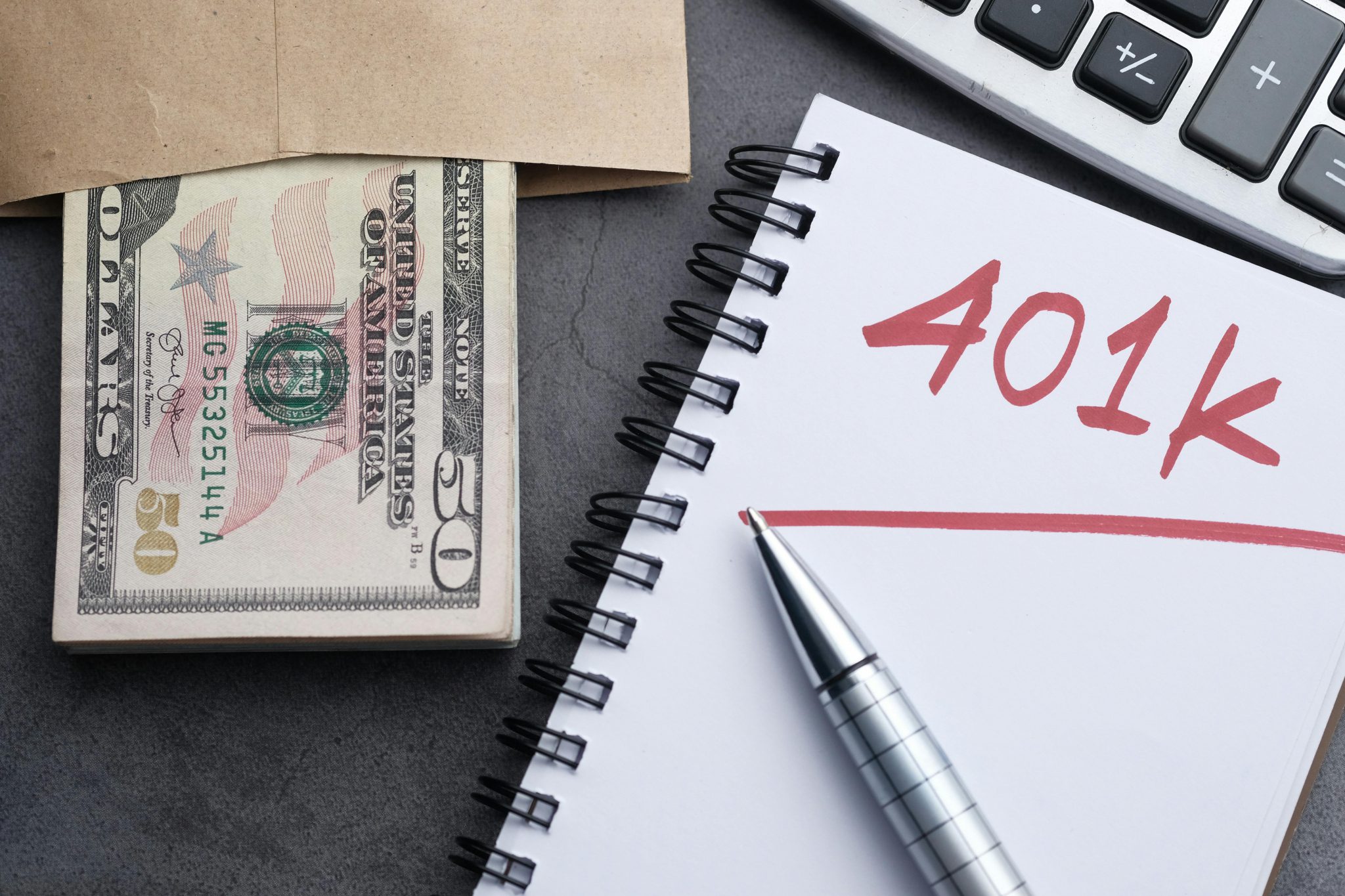A 401(k) is a retirement savings account that allows you to invest a portion of your paycheck before paying taxes.
In many cases, employers will match part of your contributions, giving your savings an extra boost. This combination of regular contributions and compound growth helps your money grow significantly by the time you retire.
Why Your 401(k) Might Be the Easiest Money You’ll Ever Earn
For many people, 401(k) forms show up on their first day of work and get dismissed with the smallest contribution possible. If that’s you, you could be missing out on thousands of extra savings.
Here’s why: Many employers offer to match 50% to 100% of your contributions, up to a certain limit. Every dollar your employer matches is a dollar you didn’t have to earn, making it one of the easiest ways to grow your wealth. All it takes is consistent contributions.
The average person misses out on $1,000 to $1,500 per year in unclaimed matching funds. Over 30 years, that can add up to more than $100,000 in lost retirement savings. That’s like walking away from a chance to buy a house, just because you didn’t check a box.
And it’s not just about the future. Contributing to a 401(k) can also reduce your taxable income, which means more take-home pay and more spending power today—all while you’re building wealth for the future.
Free Money Math: How Employer Matching Doubles Your Investment
Let’s take a quick look at how employer matching can supercharge your 401(k) investments.
Matching programs are pure gold
A 401(k) match is free money from your employer based on how much you contribute. Most companies offer this as a benefit; you can check if yours does by asking HR or reviewing your employee handbook.
Here’s how it works: A 100% match up to $2,000 means that if you contribute $2,000, your company adds another $2,000, doubling your investment instantly. Even a 50% match is a great bump; contribute $2,000, and they give you $1,000, no questions asked.
No stock or bond guarantees this kind of instant return. The magic kicks in when that free money starts compounding over time. That matched $2,000 doesn’t just sit there—it grows alongside your contributions for decades. This compounding effect can snowball into a sizable retirement fund that will offer you peace of mind in your later years.
The numbers that will shock you
Let’s break it down with a simple example.
If you start contributing $5,000 a year to your 401(k) at age 25 and your employer matches that with another $5,000, you could end up with over $2.7 million by the time you retire. Without the match, you’d only have $1.3 million. That’s half the wealth for the same effort and timeline.
Even if you start later, say at age 35, employer matching can still add more than $650,000 to your retirement fund.
Choosing not to contribute to a 401(k) when your company offers matching is like turning down a 100% pay raise. That money is already set aside for you; all you need to do is take it.
The Tax Magic That Makes Your Money Grow 40% Faster
Beyond the power of compounding, a 401(k) gives you a unique advantage: Your contributions are made before taxes, which reduces your taxable income and helps you save more. Here’s why that matters:
Pre-tax contributions cut your taxes immediately
Every dollar you contribute to a traditional 401(k) lowers your taxable income by the same amount. In other words, the government sees you as earning less than you did, so you owe less in taxes.
For example, if you earn $50,000 and contribute $5,000 to your 401(k), you’re only taxed on $45,000. If you’re in the 30% tax bracket, that contribution saves you $1,500 in taxes right off the bat.
In real terms, a $5,000 contribution only reduces your take-home pay by about $3,500. You get the full investment power of $5,000 while only reducing your spending money by $3,500. That’s like getting a rebate on investing in your future—all while your money grows tax free inside the account for decades.
Why does this beat regular investing?
With regular investing, you get taxed twice: first on the money you earn, then again on any profits you earn from investing. So if you earn $100, you might only have $70 left after taxes. Then when that $70 grows, you pay even more taxes on the gains.
With a 401(k), your full $100 goes straight into investments without being taxed; then, it . grows tax free for decades. When you eventually withdraw it in retirement, you’ll likely be in a lower tax bracket since you’ll no longer be working full time.
Over 30 years, this tax advantage can boost your returns by 40 percent or more. The same investments in a 401(k) versus a regular account could mean an extra $100,000 to $200,000 in retirement funds.
How Much Money Should You Actually Contribute?
Not sure how much to put into your 401(k)? Here’s how to get the most value from your contributions.
Start with the match, then go higher
Always aim to contribute enough to get the full employer match. Most companies match around three to six percent of your salary, so make that your first goal.
Once you hit that, aim to contribute 10 to 15 percent of your total income, including both your contributions and your employer’s. If you can’t get there right away, increase your contributions gradually over time.
If you’re just starting your career, prioritize your 401(k) before exploring other investment options. The combination of employer matching, tax advantages, and decades of compounding growth makes it one of the most powerful tools for building long-term wealth.
For a more detailed breakdown, feel free to check out my guide on How Much to Contribute to Your 401(k) by Age.
Real example to help you visualize your returns
Let’s take a look at how this works in real life:
Sarah earns $60,000 a year. Her company offers a 50% match on contributions up to six percent of her salary. That means if Sarah contributes six percent—$3,600—her company adds $1,800.
On top of that, Sarah saves roughly $1,000 on taxes thanks to her pre-tax contributions. So while she’s putting $3,600 into her 401(k), her real out-of-pocket cost is just $2,600. But her retirement account gets a total boost of $5,400 in that year alone.
Even if Sarah contributes just $100 per month, with no employer match, her investment can still grow to over $200,000 over 30 years, just from compound growth and tax savings.
For reference, the 401(k) contribution limit for the year 2025 is $23,500 for those under 50. While most people won’t be able to max it out, any amount you can contribute adds up significantly over time.
And always remember: The earlier you start, the more your money can work for you.
What Actually Happens to Your Money Inside a 401(k)
Now that you know the powerful benefits of a 401(k), let’s break down exactly where your contributions go and how they grow over time.
Your investment options explained simply
When you contribute to a 401(k), your money goes into an investment account managed by trusted financial companies like Vanguard or Fidelity. Unlike with other investments, you won’t be picking individual stocks. Instead, you choose from a list of investment funds your employer has already selected for you. If you do not make a choice, most plans will automatically place your money into a default fund, usually a target-date fund, so your money is still being invested.
If you are new to investing, target-date funds are a great option. They require no maintenance and are designed to grow with you. All you need to do is pick a fund that matches your expected retirement year, such as “Target 2055.” These funds begin with higher-growth investments when you are younger, then gradually shift to safer options as you get closer to retirement. This helps protect your savings while still giving your money the chance to grow over time.
Why simple beats complicated every time
Most 401(k) plans offer you 10 to 20 investment options. You can switch between them anytime without triggering tax penalties. This is one of the biggest advantages over regular investing, where moving your money usually results in tax consequences.
Furthermore, with simple investment tactics, you don’t need to be an expert to succeed. In fact, trying to time the market or chase trends often backfires. A simple “set it and forget it” approach of steady contributions into diversified funds almost always outperforms complex strategies.
What Happens When You Switch Jobs
Once you’ve set up your 401(k), you might wonder what happens to it if you leave your company. Here’s what you need to know when changing employers:
Rolling over protects your money and growth
When you leave a company, you have four main options for your 401(k):
Leave it with your old employer.
Roll it over to your new employer’s 401(k).
Roll it into an IRA.
Cash it out (usually the worst option due to taxes and penalties).
Rolling your 401(k) into an IRA gives you the most flexibility and control. You can open an IRA with providers like Schwab, Fidelity, or Vanguard.
Rolling over helps you keep the tax benefits while potentially unlocking better growth options. Your money stays protected and continues growing tax free, while you may get access to lower fees and more investment choices.
The simple 3-step process to roll over into an IRA
If you decide to roll over your 401(k) into an IRA, here’s how to do it:
Step 1: Open an IRA account with a trusted provider like Vanguard, Fidelity, or Schwab. Most major companies make this easy with online forms that only take 15 to 20 minutes to set up.
Step 2: Contact your previous 401(k) administrator to request a direct rollover to your new IRA. This ensures the money is transferred electronically and avoids taxes or penalties.
Step 3: Choose your investments once the money arrives in your IRA. The cash will sit uninvested until you pick funds. Log in and invest it right away to avoid missing out on growth.
The Costly Mistakes That Can Kill Your 401(k) Growth
Your 401(k) can grow into a powerful asset, but it’s not completely foolproof. Here are some common mistakes you should avoid to help you get the most out of your money:
Not contributing enough to get the full match
If your employer offers matching and you’re not contributing enough to qualify for the full amount, you’re leaving free money on the table. Even small gaps in contributions can cost you tens or hundreds of thousands over time. This is one of the most preventable mistakes, especially early in your career.
Think of the match as part of your compensation package: If you’re not taking full advantage of it, you’re essentially saying no to money that’s already yours.
Cashing out when you change jobs
Around 40 percent of people make this costly mistake: cashing out their 401(k) when they leave a job. But doing so means paying income tax plus a 10 percent early withdrawal penalty, which turns long-term savings into expensive short-term cash.
For example, cashing out a $20,000 401(k) at age 30 could cost you nearly $300,000 in lost retirement savings: the amount it could have grown to if left invested for another 35 years.
If your excuse is “I’ll start over at my new job,” you’re actively ignoring the power of compound growth. Instead of resetting your progress, roll it over and let your money keep working.
Picking overly conservative investments when you’re young
Many young people choose “safe” bond funds or stable value options out of fear. While these options protect against short-term losses, they also limit your long-term growth potential, especially when you still have decades until retirement.
Being overly conservative in your 20s and 30s can cost you hundreds of thousands of dollars. This is the stage of life when you can afford to take more risks because there’s plenty of time to recover from market downturns.
A simple way to avoid this mistake is by choosing a target-date fund. These funds start with a more aggressive investment mix and gradually become more conservative as you get older, automatically optimizing your risk levels without any guesswork.
Planning ahead for your retirement? Check out my simple guide on How Much You Really Need to Retire.
Your 401(k) Action Plan: Start This Week
If you want to make the most of your 401(k), here’s how you can take control and get started right away:
Step 1: Find out what your employer offers
Start by checking with your HR manager or logging into your employee benefits portal to review your company’s 401(k) plan. Look for key details like the matching formula, vesting schedule, and available investment options.
If you’re not already enrolled, request the sign-up forms right away. Understanding your employer’s match and how long you need to stay for that money to become fully yours can help you plan smarter.
Step 2: Set your contribution amount strategically
Aim to contribute enough to get the full employer match, even if it feels like a stretch. If the match requires six percent and that feels too high, start with three percent and increase it by one percent every few months.
Any amount is better than zero. The key is to just start, then build it gradually. A smart tactic is to bump up your contributions each time you get a raise. Since the extra money hasn’t hit your take-home pay yet, you won’t feel the difference, but your future self will.
Rather than obsessing over small daily savings, optimizing your 401(k) is a powerful, low-effort way to build long-term wealth and protect your financial future.
Step 3: Choose simple, effective investments
Once you start contributing to your 401(k), choose a target-date fund that aligns with your expected retirement year. These are great for zero-maintenance investing, as they automatically adjust and rebalance as you age.
If your plan doesn’t offer target-date funds, go for a balanced mix of stock and bond index funds. A good starting point when you’re young is 80% stocks and 20% bonds; as retirement gets closer, you can gradually shift to a more conservative mix.
Avoid putting too much into any single stock, especially your employer’s. Holding concentrated positions creates unnecessary risk when diversified funds are available. For a deeper breakdown, check out my full guide: Asset Allocation By Age.
A 401(k) isn’t just a retirement account. It’s one of the smartest, simplest tools to grow your money, lower your taxes, and build a future that supports your version of a Rich Life.


























